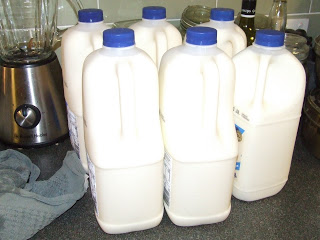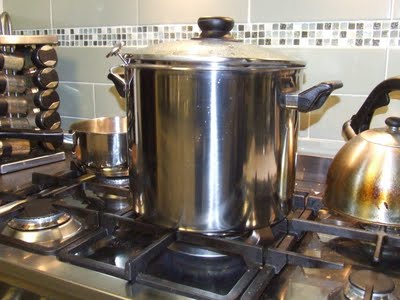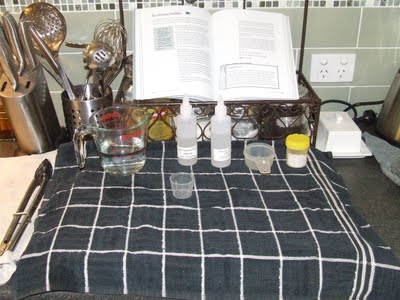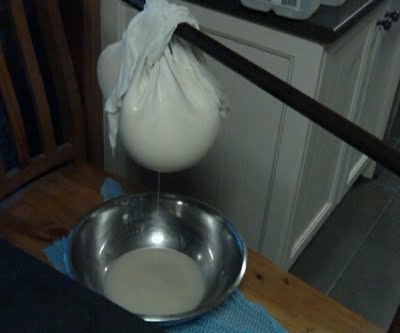Now to make things more interesting, and to save time and effort, I have decided to expand production by purchasing a new pot. Usually, I make a kilogram of cheese from 7.6 litres (1 gallon) of milk, so I bought a 15.1 litre pot so that I could simply double the recipe and make two 1kg rounds in the same time I normally make one, and all in the same pot.
It is a beauty and I picked it up for $15! The only problem is that whoever made this pot couldn’t count. It only held 14.8 litres of milk and there was no way that I could have fitted in another 300ml. Anyway, I figured that it would make enough curd to fit in two cheese moulds, which may have been a bit of a problem if I hadn’t have purchased an additional cheese press.
I purchased the press from from Green Living Australia and it arrived in 2 days. Luckily I had planned ahead and ordered it earlier on in the week about the same time I bought the large pot. The press also came with a 50lb spring, and a 1kg cheese mould and follower. I was all set. I sterilised everything in the pot except the plastic stuff, which I put on a 65C wash through the dishwasher, then sprayed with vinegar.
I set up all my ingredients. This cheese is very simple to make.
Farmhouse Cheddar
recipe for 1kg
7.6 litres full cream milk
1 heaped smidgen (1/32 teaspoon) Mesophillic direct set starter culture
1/2 teaspoon liquid rennet diluted in 60ml cool boiled water
1/2 teaspoon Calcium Chloride diluted in 60ml cool boiled water (if using homogenised milk)
1 tablespoon cheese salt (non-ionised salt)
Then I set up the sink area. I sprayed the area with vinegar and wiped it all down with a clean dry cloth.
Here is the method:
Method
Heat the milk to 32C (90F). Add the Calcium Chloride (if necessary). Add the starter and stir well. Cover and let milk ripen for 45 minutes.
Add the diluted rennet and stir gently for 1 minute. Cover and let stand at 32C for 45 minutes or until you get a clean break.
Cut the curd into 1.25cm (1/2 inch) cubes. Increase the temperature to 38C (100F) slowly, no more than 1 degree for every 5 minutes. Stir to ensure that the curds do not mat. This should take about 30 minutes and the curd will shrink a bit.
Cover the pot and let stand for 5 minutes. Pour the curds into a cheesecloth lined colander, drain for a few minutes then tie the corners of the cheesecloth into a knot and hang the bag and allow to drain for 1 hour. The curds need to stay warm so hang at room temperature.
Place the drained curds back in the pot and gently mill into walnut sized pieces. Mix in the Salt, then pack into lined cheese moulds.
Fold over cheesecloth, top with follower and press at 5kg (10lb) for 10 minutes. Remove the cheese from the mould, gently remove the cloth and turn, re-wrap, and press for 10kg (20lb) for 10 minutes. Repeat and press for 25kg (50lb) for 12 hours.
Remove from the mould and air dry the cheese on mats at room temp on a wooden board. This may take between 2-4 days depending on the season. Turn the cheese often, at least 4 times a day so that moisture does not collect on the bottom. When a thin yellow rind has formed, wax the cheese and age at 13C for at least 1 month. The longer it is left the sharper the taste.
Peppercorns
I added pink and green peppercorns to my recipe. To modify this recipe, add 1 tablespoon of peppercorns (green or pink but not dried black ones) to 1/2 cup of water and simmer for 15 minutes. Strain and reserve the water and add the liquid to the milk just before the starter. At the milling stage, add the peppercorns and mix gently but thoroughly before putting the curds into the mould for pressing. Press as per the recipe. I find this adds some zing to this cheese, even though it is wonderful without it. You will find this has a sharp taste and crumbly texture, which improves with flavour as it ages.
The entire process took about four and a half hours from milk to the last pressing. Pretty quick for a very tasty cheese.








These both look fabulous. I hope you have the right home-brew ready for when you crack one of these little babies open. Beer, cheese and crackers. Mmmmmm
I notice that in all your cheese demos, you have what appears to be a cookbook open. Do you have a favorite cheese-making recipe book that you can recommend?
Looks like a lot of fun, I may just give it a go one day! I’ve just made my own yogurt for the first time, which was very exciting.
Just one thing, though, was wondering if you could get your milk in reusable glass bottles, to save on all the plastic waste? I live in the UK and have a milkman who takes my empties away, which reduces the amount we throw away by a lot.
@ BM, hmmm, Beer! Sounds like a plan
@ Kathy P, have a look at this post titled “Tale of Two Cheese Books”. These are the two main ones I used for my cheese making recipes.
@ Louise, great work on the yoghurt. I have looked high and low for glass milk bottles, but we don’t have that service here in my neck of the woods here in Australia. Just plastic I am afraid, but fully recyclable which we do.